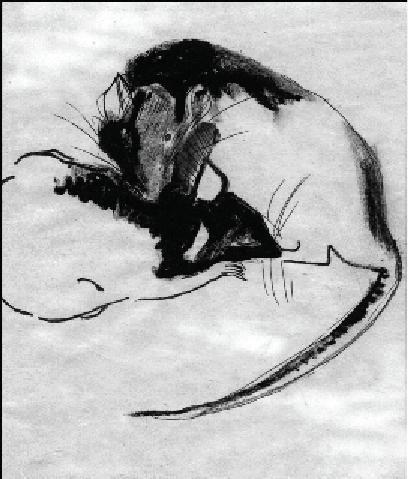Graphics Reference
In-Depth Information
Figure 1. Anna Ursyn, “Rats,” ink drawing (©
1982, A. Ursyn. Used with permission)
Without doubt, the art of illustration is closely
related to printing techniques, even when printing
is a final step of the process. A timeline of printing
techniques has been listed on Wikipedia (History
of Printing, 2013) as follows: Woodblock printing
(ancient but documented after 200), Movable type
(1040), Printing press (1454), Etching (
ca.
1500),
Mezzotint (1642), Aquatint (1768), Lithography
(1796), Chromolithography (1837), Rotary press
(1843), Offset printing (1875), Hectograph (19th
century), Hot metal typesetting (1886), Mim-
eograph (1890), Screen printing (1907), Spirit
duplicator (1923), Dye-sublimation (1957), Pho-
totypesetting (1960s), Dot matrix printer (1964),
Laser printing (1969), Thermal printing (
ca.
1972),
Inkjet printing (1976), 3D printing (1986), and
Digital press (1993).
The further text contains several illustration
projects that are inspired by biology and other
sciences, refer to various fields of our interests
and areas of our activities, and apply selected
illustration techniques.
illustrators often replace the use of pen-and-ink
with graphics software and page layout software.
Calligraphy characters are placed on computer
keyboards, specific for particular languages, for
example those used in China, Japan, Korea, or
Vietnam.
Figure 1, “Rats” results from observation of a
family of the pet black hooded rats (Rattus rattus).
Calligraphy
characters placed on computer
keyboards are specific for particular languages. In
China, it is believed a beautiful calligraphy is made
by a beautiful person: one can tell a lot about a
person's education, integrity, and talent when one
can appreciate this person's calligraphy. Arabic,
Chinese, Vietnamese, Korean, Japanese, Nepalese,
Indian, Georgian (in three alphabets from Georgia),
Persian (for many languages in Persia and contem-
porary Iran), Kufic (the old form in Iraq), Sini
(Chinese Islamic), Tibetan, Mongolian, and West-
ern calligraphies have their particular, specific
features and rules. Western calligraphy in the me-
dieval ages included the art of illumination of the
BACKGROUND INFORMATION:
TECHNIQUES
Traditional Illustration
Someone interested in traditional illustration may
produce reproducible works in several ways go-
ing beyond creating a pencil-on-paper artwork.
Traditional techniques may include the following.
Pen-and-ink illustration,
which is still used
frequently, applies ink according to the ancient
traditions. Chinese ink was used since the 23
rd
century BC, the India ink since at least the 4
th
century BC, and so was in many other countries.
For example, an old East-Asian type of brush
painting is called Sumi-E ink wash painting.
This technique also utilizes acrylic inks and uses
brushes pens, or wooden sticks. Illustrations are
made with black ink in various concentrations.
The same ink is used in calligraphy. Currently,

